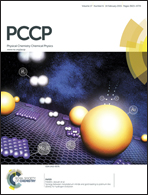Pressure-induced phase transition of BiOF: novel two-dimensional layered structures
Abstract
Bismuth oxide haloids BiOXs (X = Cl, Br, I) have received attention as photocatalytic materials after TiO2 in recent years due to their unique layered structures. Using an ab initio evolutionary methodology structure search method, we systematically investigate the evolution of BiOF structures under pressure. It is found that BiOF can maintain its layered structure up to 300 GPa. Three stable new phases with Pnma, P![[3 with combining macron]](https://www.rsc.org/images/entities/char_0033_0304.gif) m1 and Cmcm structure at a pressure of 10, 66, and 286 GPa have been identified for the first time. All the newly found phases are two-dimensional layered structures characterized by Bi–O slabs interleaved with F− anion slabs. Moreover, all three phases are indirect semiconductors with wide band gaps. It is found that pressure can cause great change in the band gaps of BiOF. The band gaps of the high-pressure phases of BiOF vary nearly linearly with pressure but exhibit different pressure trends. The electronic structure, structural stability, phase transition mechanisms and evolution of the Bi–O slabs of BiOF under pressure are discussed.
m1 and Cmcm structure at a pressure of 10, 66, and 286 GPa have been identified for the first time. All the newly found phases are two-dimensional layered structures characterized by Bi–O slabs interleaved with F− anion slabs. Moreover, all three phases are indirect semiconductors with wide band gaps. It is found that pressure can cause great change in the band gaps of BiOF. The band gaps of the high-pressure phases of BiOF vary nearly linearly with pressure but exhibit different pressure trends. The electronic structure, structural stability, phase transition mechanisms and evolution of the Bi–O slabs of BiOF under pressure are discussed.


 Please wait while we load your content...
Please wait while we load your content...